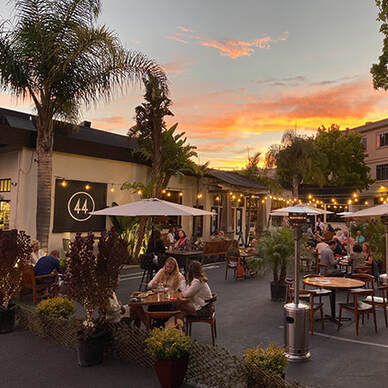 Outdoor dining at Bungalow 44.
Outdoor dining at Bungalow 44.
Citing new projections for the Bay Area’s ICU capacity above the state’s minimum of 15 percent four weeks from now, Gov. Gavin Newsom and the California Department of Public Health (CDPH) lifted the stay-at-home order statewide Monday morning, effective immediately. State officials subsequently revealed the math behind the state’s calculation in response to criticism that they were hiding key data affecting people’s lives and livelihoods.
The decision moves Marin, along with the 0ther 11 counties in the Bay Area region, back into the most restrictive purple Tier 1 within the Blueprint for a Safer Economy and lifts and loosens restrictions on businesses all over the 94941, reopening outdoor dining, indoor hair salons, barbershops and other personal services categories like skin care and massage studios, hotels.
On December 3, California Governor Gavin Newsom announced tighter restrictions for regions where less than 15% of ICU beds were available. Although the Bay Area region’s public health officers had preemptively adopted on Dec. 8, available ICU capacity in the Bay Area region slipped below the 15% threshold on December 16, officially triggering the state-mandated order for 11 Bay Area counties.
Marin could also see some additional good news in the coming weeks. All counties’ COVID-19 case counts and positive testing numbers are evaluated every week, and while Marin must remain in its current purple tier for a minimum of 3 weeks before being able to advance to the less restrictive red tier, it can move to a less restrictive tier if it attains a percent positivity rate between 5-8% for three weeks. Marin’s percent positivity rate on Jan. 22, the most recent day for which data is available, is 3.3%. MORE INFO ON THE TIER FRAMEWORK.
“Everyone has been making sacrifices to bring this surge under control, and it’s paying off,” said Marin County Public Health Officer Dr. Matt Willis in a statement. “As we move back into the purple tier, it’s critical to remember the virus is still very active in our community. We could easily backslide if we let our guard down.”
Willis said face covering, physical distancing, frequent testing, and avoiding indoor gatherings are the best ways to prevent another surge.
By switching to the purple tier, the following businesses and activities can proceed in Marin:
Allowed to operate indoors:
- Hair salons and barbershops
- Personal services (nail salons, estheticians, massage studios, tattoo parlors, piercing shops)
- Limited services (carwashes, dry cleaners, electricians, handypersons/general contractors, heating and air conditioning services, landscapers, laundromats, pet groomers, plumbing services, janitorial/cleaning services)
- Hotels, motels and short-term lodging
- Retail stores and malls, at 25% capacity
- Libraries, at 25% capacity
|
Allowed to operate outdoors:
|
|
In the day’s prior to Newsom’s announcement, state health officials told the AP that they rely on a very complex set of measurements that would confuse and potentially mislead the public if they were made public. But Dr. Lee Riley, chairman of the University of California, Berkeley School of Public Health infectious disease division, disagreed. “There is more uncertainty created by NOT releasing the data that only the state has access to,” he said in an email. Its release would allow outside experts to assess its value for projecting trends and the resulting decisions on lifting restrictions, he wrote.
With 7% of Marin residents vaccinated and very limited weekly supplies, health officials note that the vaccine will play a limited role in preventing any surges soon.
“For the next two months, our everyday behaviors, more than the vaccine, will help flatten the curve,” said Benita McLarin, Director of the Department of Health and Human Services (HHS). “It’s exciting to know we’ll all be protected eventually, through vaccination, but we’re not there yet.”

